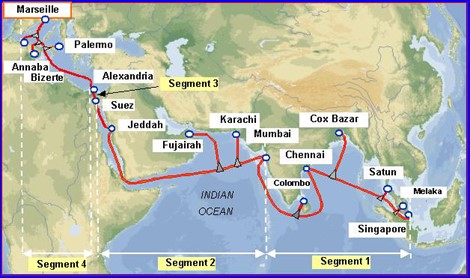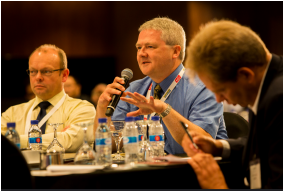|
Internet speed in Bangladesh may slow down for five days as maintenance work is being conducted on the submarine cable near Singapore, says state-run Bangladesh Telecommunications Company Ltd (BTCL). Figure 1 - SEA-ME-WE-4 Cable Map Source: SEA-ME-WE-4 Consortium
The internet speed in Bangladesh may slow from 12:00am Sunday Oct 23 to 2pm Thursday Oct 27, BTCL Director (Public Relations and Publications) Mir Md Morshed told bdnews24.com. BLTC has made several steps to ensure users will have Internet access during that period, said Morshed. “We hope our users will not have too much trouble, but Internet speed may be slightly slower,” he said. A ‘repeater’ will be replaced during maintenance work scheduled on Sunday, said a senior official at Bangladesh Submarine Cable Company Limited (BSCCL). “There may be Internet traffic outage for about three hours after midnight on Sunday,” he said “And there may also be a three-hour outage on the final day of maintenance work. ” But steps have been taken to minimise the disruption, he said. “Users may experience slowing down of speed,” he said. Prior to 2012 Bangladesh solely relied on a single submarine cable (SEA-ME-WE 4) for telecommunications. Since October 2012 International Terrestrial Cable (ITC) operators have worked to provide an alternative to the submarine cable. ITC operators are connected to different Indian telecommunications companies through terrestrial optical fibre lines. They are able to provide Bangladesh connection to international telecommunications networks when the submarine cable line is down. Six ITC operators have been purchasing bandwidth from India and distributing it in Bangladesh for the past four years. The six companies are currently providing over 160 Gbit/s to Bangladesh. Bangladesh is to receive a second submarine cable connection - SEA-ME-WE 5 – in December. The government expects the new cable to provide over to 1,300 Gbit/s of bandwidth. Source : bdnews24.com ANALYSIS: SEA-ME-WE-4 was commissioned in November 2005 although Bangladesh did not obtain connectivity until April 2006 when a terrestrial link from the cable landing station at Cox's Bazaar to Chittagong was completed. While Alcatel Submarine Networks (now known as Nokia) supplied the terrestrial and submarine DWDM line terminal equipment along the entire length of the cable system, it appears that the subsea repeaters were supplied by Fujitsu. In October 2010, two repeaters around the Thailand submarine landing station Satun needed to be replaced, and all the stations of segment-1 of SMW-4 (see Figure 1 above) were shut down for three to four hours for power reconfiguration. During the 10-day long replacement work, Bangladesh was disconnected from the eastbound circuits (South East Asia), but not from the rest of the world, as its westbound traffic (from India to America via Europe) was fully active. Eastbound traffic used the i2i cable of India's Bharti Airtel, which directly links Chennai with Singapore. It is likely that this restoration route was again used during the most recent outage but it would be politically expedient for the ITC operators in Bangladesh to claim that their investment in terrestrial connectivity to India is paying off. According to Pioneer's Cable Ship Tracking Database, the most likely vessel to have carried out this work is the ASEAN Explorer which moved from Singapore to Sembawang on October 10 before leaving for the Malacca Straits on October 12. During the period that this planned maintenance on SEA-ME-WE-4 was going on, SingTel advised that the TIS (Thailand-Indonesia-Singapore) cable which runs up the East coast of the Malaysian peninsula, also suffered an outage. The cable ship René Descartes is attending to this repair.
0 Comments
Leave a Reply. |
Julian Rawle, AuthorThought leadership articles and commentary on developments related to the subsea fibre optic cable industry can be found here. Archives
February 2018
Categories |




 RSS Feed
RSS Feed